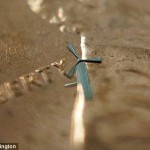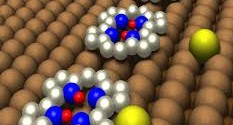 Smitha Rao, University of Texas Arlington research associate and
electrical engineering professor, along with J.C. Chiao designed and built a
micro-windmill with the ability to generate enough wind energy to effectively
recharge cell phone batteries. This may become a new solution to the problem of
cell phones running out of power and the user having to run home to
recharge.
Smitha Rao, University of Texas Arlington research associate and
electrical engineering professor, along with J.C. Chiao designed and built a
micro-windmill with the ability to generate enough wind energy to effectively
recharge cell phone batteries. This may become a new solution to the problem of
cell phones running out of power and the user having to run home to
recharge.
This micro-windmill is only 1.8 millimeters at its widest point, meaning that a grain of rice could hold roughly ten of these devices inside itself and that hundreds of these windmills could be embedded directly into the cell phone casing or the cell phone battery itself. The power would be generated by the user waving the cell phone around or holding it out of the window of a moving car.
Rao, whose work in micro-robotic devices peaked a Taiwanese company’s interest in having the duo work on designing new fabrication techniques, states, “The company was quite surprised with the micro-windmill idea when we showed the demo video of working devices. It was something completely out of the blue for them and their investors.”
Rao’s device combines aspects of origami, wafer-sized semiconductor devices, and three-dimensional moveable mechanical structures that have the ability to be self-assembled with the use of two-dimensional metal pieces. The technique uses planar multilayer electroplating, optimized by WinMEMS Technologies Company – the Taiwanese company that initially took an interest in Rao’s work.
Chiao, Rao’s partner, says “The micro-windmills work well because the metal alloy is flexible and Smitha’s design follows minimalism for functionality.”
The Taiwanese company WinMEMS gained interest in the micro-electro research at UT Arlington and started a relationship with them and Rao, visiting with them to discuss plans several times in 2013. UT Arlington and WinMEMS came to the agreement that the university, who has applied for a provisional patent on the design, would hold the intellectual properties while WinMEMS would investigate the commercial opportunities that their work would allow them. WinMEMS has been presenting the micro-windmill both in public presentations and on its website, showcasing its gears, inductors, pop-up switches and grippers. All of these parts being only a fraction the diameter of an average strand of human hair.
Eventually, inventions this small, such as the micro-windmill, could be applied to operations of high importance such as surgical tools, and sensing machines that could be sent into dangerous environments to scan for radiation or even bomb detection.
A proud Rao states, “It’s very gratifying to first be noticed by an international company and second to work on something like this where you can see immediately how it might be used. However, I think we’ve only scratched the surface on how these micro-windmills might be used.
“The problem most MEMS designers have is that the materials are too brittle. With the nickel alloy, we don’t have that same issue. They’re very, very durable.”
The windmills were successfully tested in a laboratory in September, 2013 and were found to work under very strong simulated winds without any fracture in the nickel alloy because of the brilliant aerodynamic design. The mass productions of these windmills is very inexpensive with the cost of making one of the windmills is the same as the cost of making a hundred or even a thousand of them on a single wafer.
Chiao says, “Imagine that they can be cheaply made on the surfaces of portable electronics so you can place them on a sleeve for your smart phone. When the phone is out of battery power, all you need to do is put on the sleeve, wave the phone in the air for a few minutes and you can use the phone again. Because of the small sizes, flat panels with thousands of windmills could be made and mounted on the walls of houses or buildings to harvest energy for lighting, security or environmental sensing and wireless communication.”
He is very proud that one of is former students is being recognized for his work at such a high level and states, “To see a company recognize that and seek you out for your expertise speaks volumes about what UT Arlington means to the world.”
 Nanotech
etc. Nanotechnology News
Nanotech
etc. Nanotechnology News 



